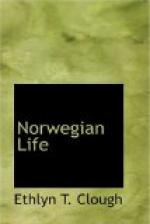The primary school system of Norway costs an average of $5.60 per child per year in the country, and $13.16 per child in the city, or $1.26 per capita of population in a year.
There is a secondary school system under the control of the national government, administered by the department of education and religion. It embraces forty-six high schools, located in different parts of the country, known as Latin-Gymnasier, or classical schools, at which students are prepared for the university, and Real-Gymnasier, or technical schools, in which they are taught English, mathematics, the natural and applied sciences, bookkeeping, stenography, and other branches that will fit them for commercial or industrial pursuits. There are also twelve cathedral schools, one for each ecclesiastical diocese, which were founded in the middle ages, and are supported by large estates acquired from the early kings and by confiscation of church property after the Reformation. There are also five private academies, attended chiefly by the sons of rich men.
The University of Christiania, which is one of the first in Europe, was founded in 1811, and has five faculties, with sixty-three professors, eighteen fellows, and about 1,450 students, of whom 70 are studying theology, 20 law, 330 medicine, and 600 are in the scientific department. The professors are appointed by the king, and receive salaries of about $950 a year, with a longevity allowance in addition amounting to about $125 every five years. The fellows are paid about $350 a year, and are provided with lodging rooms. Tuition at the university is free upon payment of a matriculation fee of $10. Women have been admitted on even terms with men since 1882, and 260 have matriculated, of whom 53 have taken degrees. The university has an endowment of $1,310,000, with legacies amounting to about $250,000 to encourage original investigations in special lines of study. The Nansen fund, which amounts to about $150,000, is intended to encourage exploration on the seas. The hospitals of Christiania are in charge of the medical department.
There are also the usual schools for the deaf, dumb, blind, weak-minded, and crippled children, supported by the state, and reform schools for the correction and restraint of the depraved. Technical schools, with day and night classes, for teaching the trades to young men and women, four schools of engineering in different parts of the country, nine industrial schools for women only, where they can be trained to earn their living by sewing, dressmaking, weaving, millinery, embroidery, and other needlework, bookkeeping, typesetting, stenography, typewriting, photography, and other lines of industry, and an art school especially patronized by the king in connection with the art gallery at Christiania, where painting, drawing, and designing, modeling, decoration, and the art of architecture are taught.




